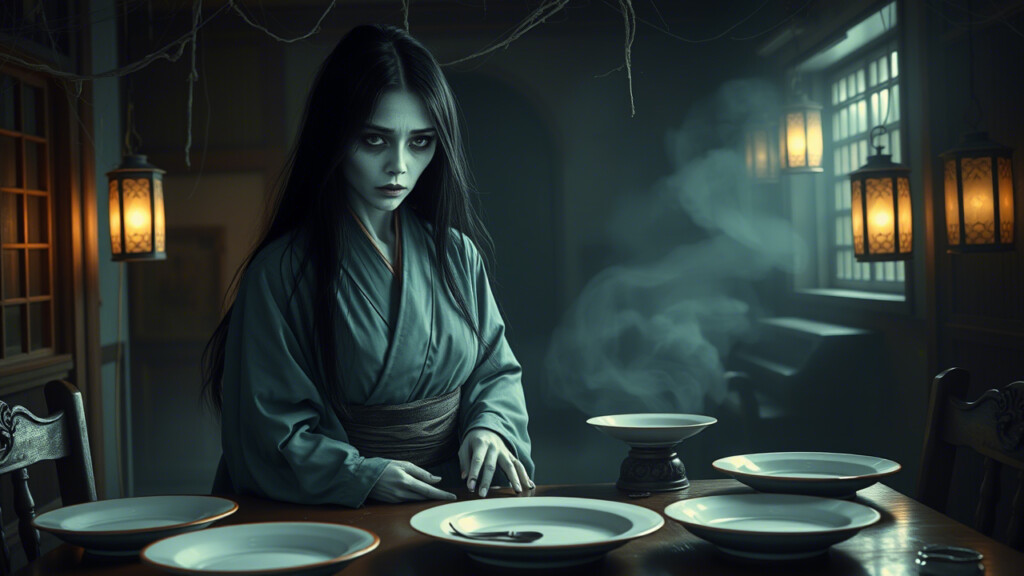In the vast collection of Japanese ghost legends, Okiku remains one of the most haunting spirits. For over 400 years, her story has been retold, tied to an ancient well, a mysterious counting voice, and the enigma of the missing tenth plate.

The Legend of Okiku – The Vengeful Spirit in the Well
The tale of Okiku originates from the Edo period (1603–1868) when the samurai class held absolute power. She was a servant at Himeji Castle, entrusted with the care of ten precious plates. But one plate mysteriously vanished—or was deliberately hidden—leading to her being falsely accused.
Her master, Aoyama Tessan, a ruthless samurai, fabricated the incident to coerce her into becoming his mistress. When she refused, he tortured her and threw her down a well—a well that still exists in Himeji today, serving as a chilling reminder of the legend.
From that night onward, a voice could be heard counting: “Ichi… Ni… San… Shi… Go… Roku… Shichi… Hachi… Kyuu…”—but never reaching “Juu.” The unfulfilled count trapped her spirit between worlds, unable to find peace.
Okiku’s story shares similarities with Oiwa from Yotsuya Kaidan, another famous ghost tale of betrayal and revenge. However, while Oiwa seeks retribution, Okiku is doomed to endlessly repeat her sorrowful count, trapped in an endless loop of despair.
Even more chilling, Okiku’s imagery is believed to have inspired Sadako from The Ring (1998)—the long-haired girl who crawls out of a well, spreading terror through an unbreakable curse.
Okiku – A Legend or a Historical Figure?
While there is no concrete historical record confirming Okiku’s existence, her story reflects the harsh realities of the Edo period. The samurai class wielded absolute control, and women like Okiku could easily fall victim to abuse and power struggles.
The tale became so popular that it was adapted into numerous Kabuki plays, most notably Banchō Sarayashiki (番町皿屋敷), where Okiku’s ghostly counting and tragic fate captivated audiences for centuries.
Similar to Otsuyu in Hyakki Yagyō (Night Parade of 100 Demons), both are restless spirits bound by sorrow. But while Otsuyu represents a tragic love story, Okiku embodies the torment of incompleteness—a haunting presence that refuses to fade.
Even in modern horror games like Fatal Frame (Project Zero), ghostly figures resembling Okiku emerge from wells, draped in long, flowing hair, with vacant, sorrow-filled eyes—a direct nod to her eerie legacy.
Breaking the Curse – Can Her Spirit Be Set Free?
Unlike other vengeful spirits, Okiku does not seek bloodshed, only liberation. One lesser-known version of the legend tells of a Buddhist monk who finally ended her suffering.
One night, as Okiku’s ghost counted to nine, the monk interjected:
“Juu!”
Her spirit froze. After centuries, she had finally “completed” her count. With that, her soul dissipated, bringing peace to Himeji Castle.
But… the whispers persist.
Visitors to Okiku’s Well in Himeji claim that, on certain nights, they can still hear a faint, distant voice counting from the depths below.
Has Okiku truly found peace? Or is this simply a tale to scare the faint-hearted?
The Number 10 – A Broken Perfection
In Shinto belief, the number 10 represents completion—the final piece that brings balance. But for Okiku, the missing plate became an eternal curse, an unfulfilled fate she could never escape.
Her cruel master descended into madness, haunted by the echo of her counting voice, as if he too had been dragged into the cycle of torment.
Compared to Otsuyu, we see an intriguing contrast:
- Okiku forever counts to nine, searching for what is lost.
- Otsuyu eternally seeks a love that no longer exists.
One is obsessed with an absence, the other refuses to accept death—two spirits trapped in endless loops, unable to move on.
Psychologically speaking, Okiku could be seen as a spectral manifestation of Obsessive-Compulsive Disorder (OCD)—a soul caught in a compulsive cycle of unfinished business, a ritual of sorrow she cannot break free from.
Has Okiku truly been freed? Or is she still waiting for her missing tenth plate?
👻 Do you believe in Okiku’s curse? Or is this just a spooky folktale meant to frighten the living? Share your thoughts!
